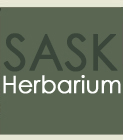|
| Antennaria umbrinella
Rydb. |
|
| |
| TAXONOMY |
| |
| Family: |
Asteraceae or Compositae |
| Genus: |
Antennaria |
| |
| Species Synonyms: |
Antennaria aizoides Greene
Antennaria flavescens Rydb.
Antennaria reflexa
E. Nels. |
| Common Names: |
brown everlasting
umber pussytoes
brown-bracted pussytoes |
| |
| DISTRIBUTION |
| |
| Canada: |
Yukon Territory – southwestern Mackenzie
District – British Columbia – southwestern and northern Saskatchewan |
| Saskatchewan: |
southwestern and northern Saskatchewan; Cypress
Hills – Stone – Val Marie, Hasbala Lake |
| Ecoregion: |
Cypress Upland, Mixed Grassland, Selwyn Lake Upland,
Tazin Lake Upland |
| |
| HABITAT |
| |
| Saskatchewan: |
dry, open, gravelly slopes |
| Associated species: |
Idaho fescue, lanceleaf stonecrop, Raynolds’sedge |
| |
| RARITY STATUS |
| |
Provincial
Status According
to Harms (2003): |
Vulnerable |
| Nature Conservancy
Status: |
G5 S2S3 |
Saskatchewan
Species at
Risk Status: |
None |
| COSEWIC Status:
|
None |
| |
| Brown everlasting
is rare to uncommon in Saskatchewan. It occurs in two general regions of
the province, southwestern and northeastern and is usually locally numerous.
No immediate threats are known but are possible in the future. |
| |
| SPECIES
DESCRIPTION |
| |
| Height: |
8 – 15 cm tall |
| Roots: |
rhizomes brown |
| Stems: |
tufted, thin, hairs short and
tangled; runners ascending, leafy |
| Leaves: |
basal, approximately 2 cm long,
> 5 mm across, spatula-shaped to inversely lanceolate, apex with sharp,
abrupt point, midvein conspicuous below, hairs white, short and tangled
|
| Inflorescence: |
scarcely nodding when young;
heads 3 – 8, clustered, 0.5 – 1 cm across; stalks short; bracts
5 – 6 mm high, tip obtuse or tapered, brown to yellow-brown to green
at base, tips pale brown, dry and membranous parts brownish to dirty white;
inner bracts blunt, entire |
| Flowers: |
petals white |
| Fruits: |
achene hairless |
| |
| ANAPHALIS
VS ANTENNARIA KEY FOR SPECIES FOUND IN SASKATCHEWAN |
| Only one species
of Anaphalis grows in Saskatchewan, but Anaphalis is very
similar in appearance to Antennaria. |
| |
|
| 1 May have runners; basal leaves conspicuous,
may be in a rosette, stem leaves few and reduced upwards, bracts white to
yellow-tinged to rose |
Antennaria |
| 1 Runners absent; basal leaves deciduous,
stem leaves many and not markedly reduced upwards, bracts pearly white |
Anaphalis |
| |
|
| ANTENNARIA
KEY FOR SPECIES FOUND IN SASKATCHEWAN |
|
| |
|
| 1 Heads solitary |
A. dimorpha |
| 1 Heads more than one |
2 |
| |
|
| 2 Runners absent, not mat forming;
basal leaves erect, commonly >8 x as long as broad, acute to short-tapered
at tip, not rosette forming |
3 |
| 2 Usually with numerous leafy runners
(though may be absent in some species if densely tufted), mat forming; basal
leaves spreading and forming rosettes |
4 |
| |
|
| 3 Bracts in 3 – 4 unequal series,
white or whitish, tapered to obtuse |
A. anaphaloides |
| 3 Bracts in 6 – 7 series, deep
brown to black, at least inner ones gradually tapered to the tip |
A. pulcherrima |
| |
|
| 4 Rosette leaves to over 5 mm wide;
heads 2 or more; achenes bumpy, at least when young |
5 |
| 4 Rosette leaves < 5 mm broad;
heads several; achenes not bumpy |
6 |
| |
|
| 5 Upper leaf surface distinctly less
hairy than lower, becoming hairless with age |
A. neglecta* |
| 5 Upper leaf surface nearly as densely
hairy as lower, hairless only in extreme age |
A. parvifolia** |
| |
|
| 6 Bracts with dark spot at the base |
A. corymbosa |
| 6 Bracts without dark spot at base |
7 |
| |
|
| 7 Bracts pink to rose |
A. rosea |
| 7 Bracts white, brown, yellow-brown
or green at base |
8 |
| |
|
| 8 Young flowering heads not nodding,
bracts brown, yellow-brown or green at base, dry and membranous parts brown
or whitish |
A. umbrinella |
| 8 Younger flowering heads nodding,
inner bracts white-brown |
A. microphylla |
| |
|
| *there are three
varieties in Saskatchewan, not addressed in this key |
|
| ** once considered
A. aprica if: bracts 8 – 13 mm high; stem leaves 5 –
7, and A. parvifolia if: bracts 4 – 7 mm high; stem leaves
8 – 12 |
|






